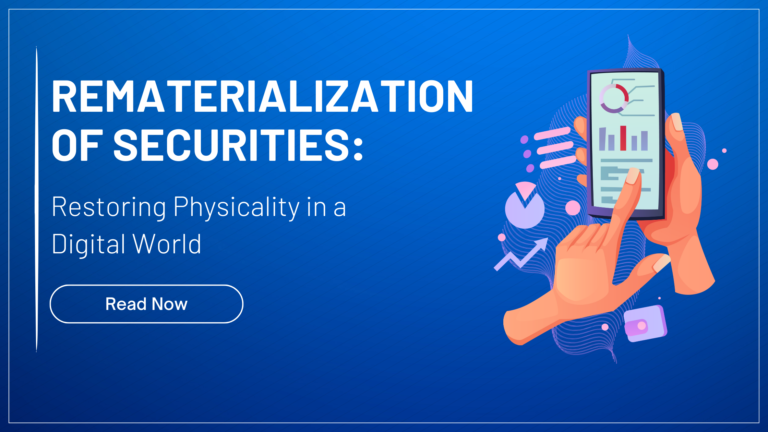
Rematerialization of Securities: Restoring Physicality in a Digital World
Introduction:
Rematerialization of securities offers the option to convert electronic holdings back into physical certificates. In this blog, we delve into the concept of rematerialization, its significance, and its role alongside dematerialization.
1. Understanding Rematerialization :
Rematerialization is the process of converting electronic holdings of securities back into physical certificates. It provides investors with the choice to receive physical copies of their securities, thereby reintroducing a tangible aspect to their investments. Rematerialization acts as a counterpart to dematerialization, offering flexibility in the way securities are held.
2. Reasons for Rematerialization :
a) Investor Preference: Some investors have a personal preference for physical certificates, either for sentimental reasons or to have a tangible representation of their investments.
b) Legal or Regulatory Requirements: In certain jurisdictions, regulations may mandate the availability of physical certificates for specific types of securities or transactions.
c) Estate Planning: Physical certificates can play a role in estate planning, allowing investors to pass down tangible assets to beneficiaries.
3. The Rematerialization Process :
To rematerialize securities, investors typically initiate a request with their depository participant (DP) or broker. The DP coordinates with the central depository to convert the electronic holdings into physical certificates. The investor then receives the physical certificates, which can be stored securely or traded in physical markets, if applicable.
4. Advantages and Limitations :
a) Tangibility and Sentimental Value: Physical certificates provide investors with a sense of ownership and nostalgia, appealing to those who value the physical aspect of their investments.
b) Compliance with Legal Requirements: Rematerialization ensures compliance with regulations that may necessitate the possession of physical certificates.
c) Inconvenience and Risks: Physical certificates can be cumbersome to handle, store, and transfer. They are also susceptible to loss, theft, damage, and forgery, unlike their electronic counterparts.
5. Rematerialization Worldwide:
The availability and popularity of rematerialization vary across different countries and markets. Some jurisdictions provide the option for investors to rematerialize their securities upon request, while others have fully embraced dematerialization, making rematerialization less prevalent.
6. The Coexistence of Dematerialization and Rematerialization (400 characters):
Dematerialization and rematerialization are not mutually exclusive; they coexist to cater to different investor preferences and regulatory requirements. The choice between the two depends on factors such as convenience, security, legal obligations, and individual preferences.
Conclusion:
Rematerialization allows investors to reintroduce a physical aspect to their electronic holdings, providing flexibility and catering to personal preferences and regulatory requirements. As the financial world continues to evolve, the coexistence of dematerialization and rematerialization offers investors a range of options to suit their needs.
